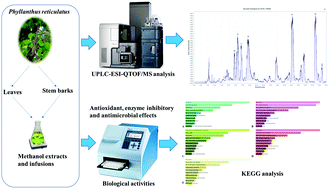New insights on Phyllanthus reticulatus Poir. leaves and stem bark extracts: UPLC-ESI-TOF-MS profiles, and biopharmaceutical and in silico analysis†
Abstract
In this paper, the methanol and water extracts of Phyllanthus reticulatus Poir. leaves and stem bark parts were considered as the source of bioactive constituents; thus, chemical analysis and bioactivity assays were performed. UPLC-ESI-QTOF/MS analysis allowed the identification of phytoconstituents in the various extracts, including 19 phenolic acids, 27 flavonoids, 20 tannins and 4 iridoids. The methanol extract of stem bark presented a higher antioxidant activity (DPPH: 3.04 mmol TE g−1; ABTS: 4.72 mmol TE g−1; CUPRAC: 3.61 mmol TE g−1 and FRAP: 1.64 mmol TE g−1) compared with other extracts. The highest inhibitory effects (AChE: 2.56 mg GALAE g−1; tyrosinase: 76.25 mg KAE g−1; amylase: 0.71 mmol ACAE g−1; glucosidase: 0.98 mmol ACAE g−1 and elastase: 2.64 mg CE g−1) were also recorded by the methanol extract of stem bark. The bacteriostatic (MIC) and bactericidal (MBC) effects of the extracts obtained from different plant parts and using different solvents were evaluated using clinically relevant microorganisms and the measured values were in the range of the activity measured for the reference compounds streptomycin and ampicillin. Bioinformatics analysis was performed to predict the potential toxicity of the identified compounds as well as potential targets of bioactivity. Five of the major compounds, erythrin, gardenoside, phlorizin, sesamoside and veracylglucan B, were identified as possible modulators of necroptosis pathways. Besides, particular attention must be paid to some identified compounds (i.e. icariin, isomyricitrin, methylmyricetin rhamnoside-gallate, rhapontin, silybin, xyloccensin R, vanilloylajugol) because of their probable immunotoxicity predicted properties. Our results could provide a great scientific starting point on the way from the bench to functional applications through the use of P. reticulatus, namely novel nutraceuticals, pharmaceuticals and cosmeceuticals.



 Please wait while we load your content...
Please wait while we load your content...